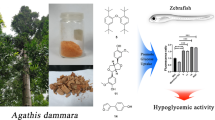Abstract
Linalool is a monoterpene compound reported to be a major component of essential oils in, various aromatic species. Several Linalool-producing species are used in traditional medical systems, includingAeolanthus suaveolens G. Dom (Labiatae) used as anticonvulsant in the Brazilian Amazon. Psychopharmacological in vivo evaluation of Linalool showed that this compound have dose-dependent marked sedative effects at the Central Nervous System, including hypnotic, anticonvulsant and hypothermic properties. The present study reports an inhibitory effect of Linalool on Glutamate binding in rat cortex. It is suggested that this neurochemical effect might be underlining Linalool psychopharmacological effects. These findings provide a rational basis for many of the traditional medical use of Linalool producing plant species.
Similar content being viewed by others
References
Foster, G. M. 1976. Disease etiologies in non-western medical systems. American Anthropologist 78:773–782.
Farnsworth, N. R. 1988. Screening plants for new medicines. Pages 83–97,in Wilson, E. O. and Peter, F. M. (eds.), Biodiversity, National Academic Press, Washington DC, Chapter 9.
Adesina, S. K. 1982. Studies on some plants used as anticonvulsants in Ameridian and African traditional medicine. Fitoterapia 53(5–6):147–162.
Chauhan, A. K., Dobhal, M. P., and Joshi, B. C. 1988. A review of medicinal plants showing anticonvulsant activity. J. Ethnopharm. 22:11–23.
Elisabetsky, E., and Setzer, R. 1986. Caboclo concepts of disease, diagnosis and therapy: implications for ethnopharmacology and health systems in Amazonia. Pages 243–278,in Parker, E. P. (ed.). The Amazon Caboclo: historical and contemporary perspectives, Studies on Third World Societies, Vol. 32.
Elisabetsky, E., Souza, G. P. C., Santos, M. A. C., Siqueira, I. R., and Amador, T. A. 1994. Sedative properties of Linalool. Fitoterapia, submitted.
Collingridge, G. L., and Lester, R. A. 1989. Excitatory amino acid receptors in the vertebrate central nervous system. Pharmacol. Rev. 40(2):143–208.
Fonnum, F. 1984. Glutamate: a neurotransmitter in mammalian brain. J. Neurochem. 42:1–11.
Gasic, G. P., and Heinemann, S. 1991. Receptors coupled to ionic channels: the glutamate receptor family. Cur. Opin. Neurobiol. 1:20–26.
Schoepp, D. D., and Conn, P. J. 1993. Metabotropic glutamate receptors in brain function and pathology. TIPS 14:13–20.
Swinyard, E. A., White, H. S., and Wolf, H. H. 1988. Mechanisms of Anticonvulsant Drugs. ISI Atlas of Science: Pharmacology. 2:95–98.
Meldrum, B. S. 1990. Mechanism based approaches to anticonvulsant therapies: modulation of inhibitory and excitatory transmission. Pages 31–43,in Meldrum, B. S. and Williams, M. (eds.), Current and future trends in anticonvulsant, anxiety and stroke therapy: proceedings of a symposium held at Princeton, New Jersey. Wiley-Liss, Inc. New York.
Cotman, C. W., and Iversen, L. L. 1987. Excitatory amino acids in the brain-focus on NMDA receptors. TINS 10(7):263–265.
Hepler, J. R., and Gilman, A. G. 1992. G proteins. Trends Pharmacol. Sci. 17:383–387.
Birnbaumer, L., Abramowitz, J., and Brown, A. M. 1990. Receptor-effector coupling by G proteins. Bioch. Biophys. Acta. 1031:163–224.
Brown, A. M. 1993. Membrane-delimited cell signaling complexes: direct ion channel regulation by G proteins. J. Membrane Biol. 131:93–104.
Souza, D. O., and Ramirez, G. 1991. Effects of guanine nucleotides on kainic acid binding and on Adenylate cyclase in chick optic tectum and cerebellum. J. Mol. Neurosci. 3:39–45.
Albano, J. D. M., Barnes, G. D., Naudsley, D. V., Brown, B. L., and Ekins, R. P. 1974. Factors affecting the saturation assay of cyclic AMP in biological systems. Anal. Biochem. 60:130–141.
Tovey, K. C., Oldham, K. G., and Whelam, J. A. M. 1974. A simple direct assay for cyclic AMP in plasma and other biological samples using an improved competitive protein binding technique. Clin. Chim. Acta. 56:221–234.
Lowry, O. H., Rosebrough, N. J., Farr, A. L., and Randall, R. J. 1951. Protein measurement with the Folin phenol reagent. J. Biol. Chem. 193:265–275.
Samuelsson, G. 1989. Nature as a source of new drugs. Acta. Pharm. Nord. 1(3):111–116.
Carlini, E. A., Contar, J. D. P., Silva-Filho, A. R., Silveira-Filho, N., Frochtengarten, M. L., and Bueno, O. F. A. 1986. Pharmacology of lemongrass (Cymbopogon citratus Stapf.). I. Effects of teas prepared from the leaves on laboratory animals. J. Ethnopharm. 17:37–64.
Santos, C. A. M., Torres, K. R., and Leonarst, R. 1988. Plantas medicinais (herbarium, Flora et scientia). Editora Icone. São Paulo, Brazil.
Elisabetsky, E., and Castilhos, Z. C. 1990. Plants used as analgesics by Amazonian caboclos as a basis for selecting plants for investigation. Int. J. Crude Drug Res. 28(4):49–60.
Wannamacher, L., Fuchs, F. D., Paoli, C. I., Gianupi, A., Fillmann, H. S., Hasegawa, C. Y., Ribeiro, A. M. S., Muller, A. L., Lanca, E., and Marques, A. 1990. Plants employed in the treatment of anxiety and insomnia. I. An ethnopharmacological survey in Porto Alegre, Brazil. Fitoterapia. 16:445–448.
Sweetnam, P. M., Caldwell, L., Lancaster, J., Bauer, Jr., C., McMillan, B., Kinnier, w. J., and Price, C. H. 1993. The role of receptor binding in drug discovery. J. Nat. Prod. 56(4):441–455.
Author information
Authors and Affiliations
Rights and permissions
About this article
Cite this article
Elisabetsky, E., Marschner, J. & Onofre Souza, D. Effects of linalool on glutamatergic system in the rat cerebral cortex. Neurochem Res 20, 461–465 (1995). https://doi.org/10.1007/BF00973103
Accepted:
Issue Date:
DOI: https://doi.org/10.1007/BF00973103




